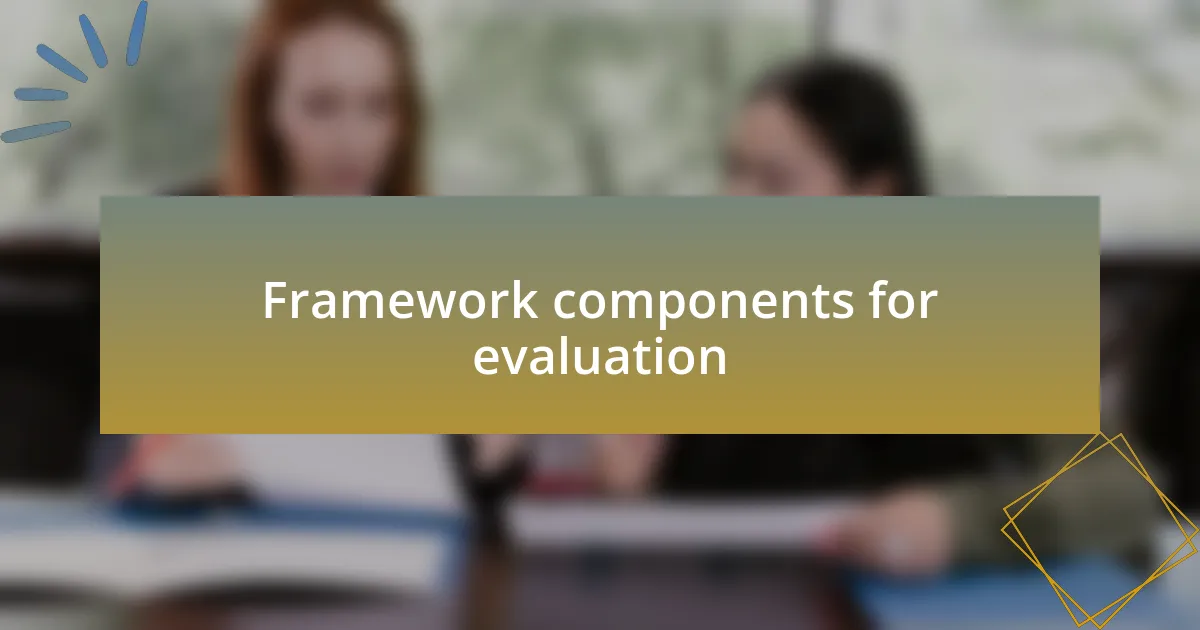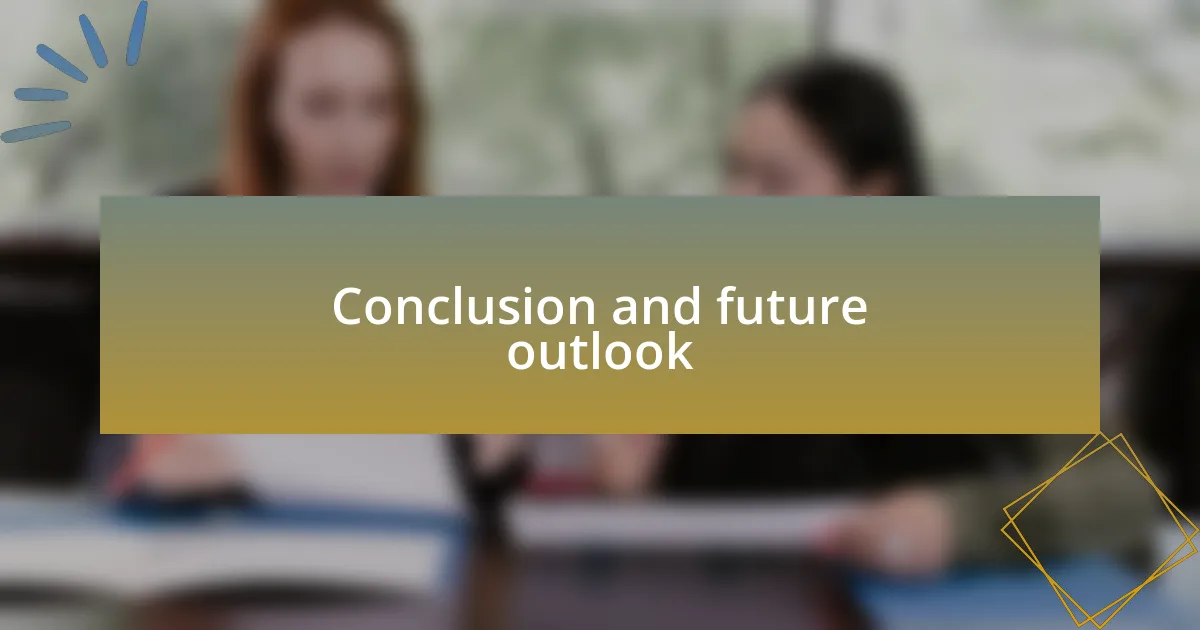Key takeaways:
- Music awards celebrate artistic talent and influence industry trends while serving as platforms for social expression.
- Fair award evaluation is essential for maintaining credibility and fostering growth among artists.
- Key evaluation criteria include originality, technical excellence, and emotional impact to reflect the true essence of music.
- Implementing transparency, diverse judging panels, and regular feedback from artists can enhance the award assessment process.

Overview of music awards
Music awards hold a unique place in our cultural landscape, serving as a celebration of artistic talent and achievement. As someone who has often been captivated by the thrill of awards season, I can tell you there’s an unmistakable excitement in the air. These events not only honor outstanding musicians but also influence trends and the industry’s direction.
When I think about the diversity of music awards, it’s fascinating how they range from prestigious ceremonies like the Grammys to genre-specific accolades. Each award showcases a different facet of the music world, which raises questions like, “What truly defines excellence in music?” For me, it’s about the emotional connection a song creates, transcending mere technical skill.
Moreover, the impact of these awards extends beyond recognition. Artists often use this platform to address social issues, inspire others, or share personal stories that resonate deeply with fans. Reflecting on how such moments can shift perspectives or spark conversations makes awards night much more than just a glamorous event—it’s a powerful moment of expression for everyone involved.

Importance of award evaluation
Award evaluation is crucial because it ensures a fair and consistent assessment of artistic merit. I remember attending a music awards show where the nominees included emerging artists alongside established stars. It struck me how important it is to evaluate their work objectively, as recognition can dramatically change an artist’s career trajectory.
It also plays a significant role in maintaining the integrity of the awards themselves. If the evaluation process lacks transparency, it raises questions about credibility. Can we truly trust an award that seems influenced by popularity rather than merit? These concerns can overshadow the true purpose of celebrating music.
Moreover, evaluating awards fosters growth within the industry. When artists receive constructive feedback through the evaluation process, it encourages them to evolve and challenge their own boundaries. I’ve seen musicians take criticism and turn it into a source of inspiration, leading to incredible works that contribute to the evolving soundscape of the music world.

Criteria for evaluating awards
Evaluating awards is often about setting clear, measurable criteria that resonate with the essence of music itself. From my experience, the first criterion that stands out is originality. How many times have we heard a song and thought, “Wow, I’ve never heard anything quite like this”? Recognizing creativity not only celebrates innovation but also inspires others in the industry to take bold risks.
Another critical aspect is the technical excellence of the performance or production. I recall attending a live event where the sound quality made all the difference, elevating the experience. It made me wonder: shouldn’t award evaluations consider the skill and effort behind a piece, not just its popularity? When we focus on technical proficiency, we honor those who dedicate themselves to mastering their craft, giving them the recognition they truly deserve.
Finally, the emotional impact of music shouldn’t be overlooked. A song can move us, make us feel seen, or transport us to another time and place. I’ve had moments where a particular track played at a pivotal moment in my life, highlighting its immense influence. How do we quantify that? In evaluating awards, we must weigh emotional resonance alongside technical skill and originality to capture the full spectrum of what music represents.

Framework components for evaluation
The framework for evaluation in music awards consists of several core components that shape the measurement of deserving talent. One essential element is the cultural relevance of the work. There have been times when a song perfectly encapsulated the societal mood or a pivotal moment in history, striking a chord with listeners on a deeper level. How can we ignore the context in which a song is created when it can carry such immense significance?
Another vital component is the narrative behind the music. I’ve often found that the stories artists tell through their lyrics or performances resonate not just with me, but with entire communities. For instance, I once attended a workshop where a songwriter spoke about the inspiration behind a particular ballad. The personal journey reflected in that song added profound layers to my appreciation. Evaluating the narratives adds depth to our assessments and honors the real human experiences that inform artistic expression.
Finally, the impact on the listener plays a crucial role in my evaluation framework. I believe it’s important to consider how music affects people’s lives long after the last note fades. Reflecting on my own experiences, I can pin down specific songs that have inspired change or provided comfort during tough times. How do we encapsulate this kind of influence when awarding artists? To truly evaluate music, we should measure the lasting impressions it leaves on audiences, enhancing our understanding of its power in shaping culture.

Personal experiences in award evaluations
When I first participated in judging a music award, I was struck by how personal the experience felt. Each submission carried with it not just notes and rhythms, but a part of the artist’s soul. I remember listening to an indie track that drew me in with its raw emotion; it reminded me of how I felt during a significant life change. This connection made me ponder: how do we measure this level of intimacy when evaluating music?
During another evaluation session, I found myself immersed in the stories woven into the lyrics. One song poignantly described overcoming adversity, echoing my own experiences during a difficult period in my life. I felt a rush of empathy, and it became clear to me that the emotional weight of a song can influence its place in award rankings. Have you ever felt a song resonate so deeply that it almost felt like a lifeline? That’s the kind of impact that we must consider in our assessments.
Reflecting on my experiences, I realized that the moments I cherish most are the ones where music acted as a bridge between artists and their listeners. There was a time when a powerful performance left the audience, including myself, in tears. It struck me that awarding artists means recognizing these deeper connections—acknowledging how their work can influence lives in profound ways. How can we not reward those who heal, inspire, and connect through their art?

Best practices for award assessment
When assessing awards, transparency in the judging process is essential. I remember a specific event where the judges openly discussed their criteria with the nominees. This practice not only built trust but also sparked thoughtful dialogues about what makes a piece deserving of recognition. How often do we prioritize clarity in evaluations to ensure fairness?
Another best practice involves creating a diverse judging panel. During one evaluation, the inclusion of judges from various musical backgrounds enriched our discussions. I noticed how this diversity led us to consider different perspectives on what constitutes quality in music. It’s astounding how varied artistic viewpoints can deepen our understanding of a submission’s impact.
Finally, I believe incorporating regular feedback from previous nominees is crucial. I once spoke to a talented artist who shared their thoughts on our evaluation process, highlighting areas for improvement. Their insights were invaluable, reminding me that we must continuously refine our methods to reflect the evolving landscape of music and its cultural significance. Isn’t it vital to listen to the voices of those we aim to celebrate?

Conclusion and future outlook
Reflecting on the frameworks and practices discussed, it’s clear that a robust evaluation system is critical to the integrity of music awards. I once participated in a panel where the results were openly debated, and the passion from both judges and nominees was palpable. This kind of open dialogue not only fosters a sense of community but also keeps us accountable. What if every awards ceremony adopted a similar approach?
Looking toward the future, I foresee a growing emphasis on digital innovation within assessment methodologies. I remember presiding over an evaluation where we utilized an online platform for submissions and feedback, allowing for a broader reach and more inclusive participation. The experience highlighted how technology can enhance our evaluations. Could tech solutions like AI or machine learning one day play significant roles in assessing complex artistic contributions?
As we move forward, it’s essential to adapt our evaluation strategies to reflect the changing dynamics of the music industry. I find myself often contemplating how rapidly music genres evolve and the impact this has on our understanding of artistry. How can we ensure that our criteria keep pace with these shifts? I believe that by continuously engaging with artists and industry trends, we can shape award evaluations that truly honor the breadth of talent in the music world.